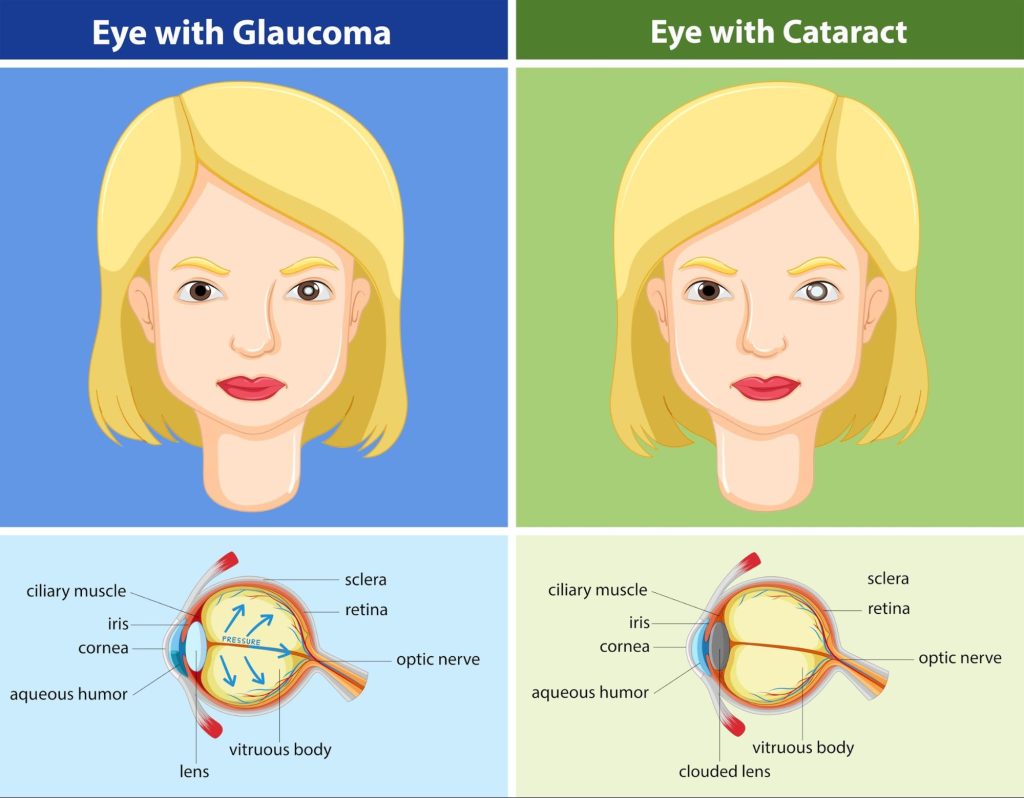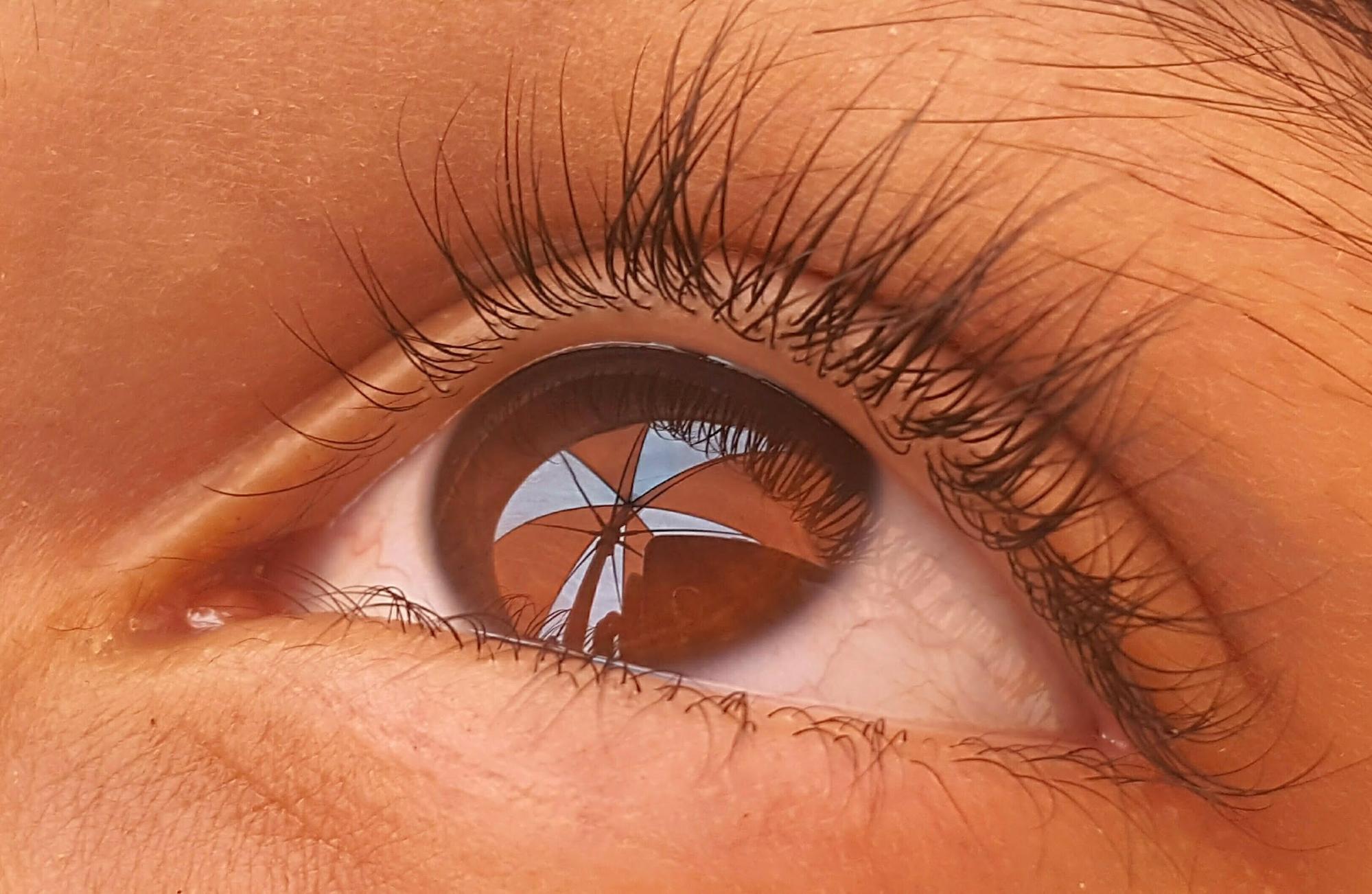Introduction
Glaucoma is a group of eye diseases that damage the optic nerve, a vital part of the vision system. One of the main causes of this damage is elevated intraocular pressure (IOP), commonly known as eye pressure.
The eye continuously produces a clear fluid called aqueous humour, which nourishes the eye and helps maintain its internal pressure. This fluid typically drains through the trabecular meshwork, a spongy tissue located near the base of the cornea. Proper drainage helps keep the pressure inside the eye balanced.
However, when this drainage system doesn’t work well, either due to blockage or reduced outflow, the fluid starts to build up. This buildup causes increased pressure inside the eye, eventually damaging the optic nerve.
In addition to high eye pressure, reduced blood flow to the optic nerve can also lead to damage. Both high pressure and poor circulation can increase the risk of developing glaucoma or make the condition worse over time.

Types of Glaucoma
Glaucoma comes in several forms, each affecting the eye’s drainage system and optic nerve differently. Below are the most common and less common types:
-
- Primary Open-Angle Glaucoma
This is the most common type of glaucoma. It develops slowly and painlessly, usually without any noticeable symptoms in the early stages. - Primary Angle-Closure Glaucoma
This type happens when the drainage angle between the iris and cornea suddenly or gradually becomes blocked. It can lead to a quick rise in eye pressure and damage to the optic nerve. - Chronic Angle-Closure Glaucoma
A slower form of angle-closure glaucoma.It develops over time, often without obvious symptoms. This makes it harder to detect early and can result in undetected optic nerve damage over time. - Narrow Angle Glaucoma
The drainage angle between the iris and cornea is very narrow, increasing the risk of sudden blockage. This can cause a rapid rise in eye pressure and may lead to vision loss if not treated quickly. - Normal Tension Glaucoma
Optic nerve damage happens even though eye pressure is within the normal range. The exact cause is not fully understood, but reduced blood flow to the nerve may play a role. - Secondary Glaucoma
This type develops due to another eye condition, such as inflammation, trauma, bleeding, or side effects from medications. It is classified based on its specific cause.
- Primary Open-Angle Glaucoma
- Less Common Types of Glaucoma
-
- Acute Angle-Closure Glaucoma – A sudden, severe form of angle-closure glaucoma.
- Pigmentary Glaucoma – Caused by pigment granules from the iris blocking the drainage angle.
- Congenital Glaucoma – A rare form present at birth due to abnormal eye development.
The Silent Thief of Sight: Understanding Glaucoma Symptoms
In its early stages, glaucoma often causes no noticeable symptoms, which is why it’s commonly referred to as the “silent thief of sight.” Recognizing the signs early is critical to prevent permanent vision loss.
Open-Angle Glaucoma Symptoms (Slow and Subtle)
- Gradual loss of peripheral (side) vision
- Mild eye discomfort
- Vision disturbances
Many people do not notice symptoms until advanced stages, making regular eye exams essential.
Angle-Closure Glaucoma Symptoms (Medical Emergency)
- Sudden, Intense eye pain
- Blurred vision
- Halos around lights
- Headache
- Nausea or vomiting
These symptoms require immediate medical attention.
How Glaucoma Is Diagnosed
Glaucoma can only be diagnosed through a comprehensive, dilated eye examination. This exam includes several key tests to detect damage and assess your risk:
- Tonometry – measures eye pressure to assess risk of glaucoma
- Pachymetry – measures corneal thickness, which can affect pressure readings
- Optic nerve evaluation – to check for signs of damage
- Visual field testing – assesses peripheral vision loss
- Optical Coherence Tomography (OCT) – provides detailed images of the optic nerve and retina
Early detection is vital to prevent irreversible vision loss.
Glaucoma Treatment: Protecting Your Vision
The goal of glaucoma treatment is to lower intraocular pressure (IOP) and prevent further damage to the optic nerve. While vision loss from glaucoma cannot be reversed, treatment can help preserve remaining sight.
Common treatment options include:
- Medications – Eye drops or oral medications to reduce eye pressure
- Laser procedures – Such as laser trabeculoplasty to improve fluid drainage
- Surgical options – Including trabeculectomy or Minimally Invasive Glaucoma Surgery (MIGS) to create new drainage pathways
Regular monitoring and early intervention are key to successful long-term management.
Family History and Glaucoma
Having a family history of glaucoma significantly increases your risk of developing the condition. Genetics play a major role, particularly in cases of primary open-angle glaucoma, the most common form. If you have a parent, sibling, or child with glaucoma, your chances of developing it are much higher. Regular, comprehensive eye exams are essential for early detection and to prevent irreversible vision loss.

Complications of Glaucoma: What’s at Risk?
If glaucoma isn’t properly managed, it can lead to serious and permanent complications. The biggest risk is irreversible vision loss caused by ongoing damage to the optic nerve.
As the disease progresses, you may develop blind spots in your vision. This can make everyday activities like reading, driving, or recognizing faces much harder.
In severe cases, untreated glaucoma can cause total blindness, greatly affecting your independence and quality of life. Older adults are at higher risk of falls and injuries due to poor vision.
Hence, regular eye check-ups and sticking to your treatment plan are the best ways to prevent these complications and protect your sight.

Glaucoma in Children
Although rare, childhood glaucoma, also known as congenital glaucoma can have serious consequences if not detected and treated early. This type of glaucoma may be present at birth or develop during infancy or early childhood. Early signs may include excessive tearing, sensitivity to light, redness in the eyes, and sometimes eyes that appear larger than normal or look cloudy.
Glaucoma and Other Health Conditions
Certain health conditions can increase your risk of developing glaucoma, especially primary open-angle glaucoma. People with diabetes, ocular hypertension, or vascular conditions may be at higher risk. Additionally, long-term use of steroid medications, such as corticosteroid eye drops, pills, or inhalers, can raise IOP and contribute to glaucoma risk.
If you have any of these conditions, it’s important to work closely with your eye specialist and have regular comprehensive dilated eye exams. Early detection and proactive management can help slow or prevent vision loss from glaucoma.
Nutrition and Eye Health
Eating a healthy, balanced diet supports overall eye health and may help in managing certain risk factors associated with glaucoma. Antioxidant-rich foods like leafy greens, berries, and colorful fruits and vegetables help protect the eyes from oxidative stress. Omega-3 fatty acids, found in fatty fish, nuts, and seeds, may reduce inflammation and support retinal and optic nerve health.
Staying hydrated is important too, but it’s best to drink water steadily throughout the day rather than consuming large amounts at once, which can temporarily raise eye pressure.
While good nutrition contributes to healthy vision, it’s important to understand that diet alone cannot prevent or treat glaucoma. Always follow your eye specialist’s recommendations for monitoring and managing the condition.

Lifestyle and Support
With proper care, people with glaucoma can live full, active, and independent lives. The key is consistency: follow your treatment plan as prescribed, attend regular eye check-ups, and adopt a healthy lifestyle. This includes:
- Eating a balanced, nutrient-rich diet
- Exercising regularly, as advised by your doctor
- Managing stress, which may help maintain overall well-being and eye health
Having a strong support system—including family, friends, and your healthcare team—can make a big difference in managing the emotional and physical aspects of the condition. It’s natural to feel overwhelmed at times, but you’re not alone.
Trusted organizations, such as the Glaucoma Research Foundation and the National Eye Institute, offer reliable information on risk factors, treatment options, and the latest research developments. You can also explore support groups, whether in-person or online, to connect with others who truly understand what you’re going through. These communities often provide encouragement, helpful tips, and emotional support.
Your eye specialist and healthcare providers are your partners in this journey. They can guide you in adjusting your routine, monitoring your progress, and managing any challenges that come up along the way.
By making use of these resources and surrounding yourself with support, you can take control of your glaucoma, protect your vision, and maintain a strong quality of life.
Preventing Glaucoma and the Future of Treatment
Although glaucoma can’t be entirely prevented, early detection through regular, comprehensive eye exams is the most effective way to protect your vision. Healthy lifestyle choices—such as not smoking, engaging in regular physical activity, and limiting excessive caffeine intake—may help lower risk or slow disease progression.
On the research front, scientists are exploring innovative treatments like stem cell and gene therapies aimed at protecting or regenerating optic nerve cells. At the same time, advances in diagnostic imaging, AI-assisted tools, and less invasive surgical techniques are improving the precision and effectiveness of glaucoma care.
Conclusion
Glaucoma is a severe eye disease that can lead to permanent vision loss if not detected and treated early. People with risk factors such as a family history of glaucoma or older age are at higher risk and should be especially aware.
With early diagnosis, consistent treatment, and a healthy lifestyle, many people live full, active lives while managing the condition.



